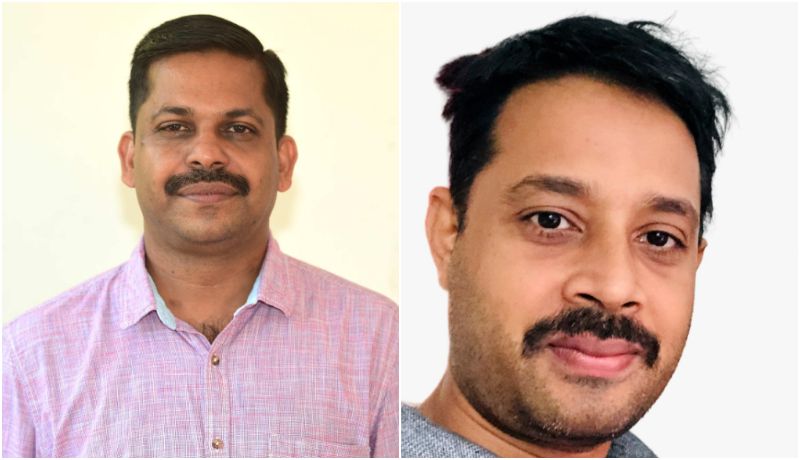Leonard Fernandes, Cofounder, CinnamonTeal Publishing: Winner of British Council Young Creative Entrepreneur Award 2010 in Publishing
Tuesday September 28, 2010 , 12 min Read

A self-publishing platform wins award this year
In photo: CinnamonTeal founders Queenie and Leonard
Leonard Fernandes initially found that used books are not a business proposition in India. In 2006, he founded Dogears etc., an online used book library, with his wife Queenie but customer feedback and requests helped him start CinnamonTeal Publishing, a self-publishing platform providing end-to-end support for authors. CinnamonTeal differentiates by acquiring ISBN for the author’s book, thereby listing it in indexes for search internationally and by aggressively marketing the book. Leonard has ambitious plans to grow CinnamonTeal and publish in regional languages and offer mobile applications for books. In a conversation with Venkatesh Krishnamoorthy (chief evangelist of YourStory), he shares his entrepreneurial journey, what CinnamonTeal is all about, and his perspective on entrepreneurship.
To read more about the Young Creative Publishing Entrepreneur Award click here. To follow British Council Young Creative Entrepreneur Award on Facebook click here.
Congratulations Leonard on winning the Young Creative Entrepreneur Award in publishing for 2010 from British Council. How do you feel and what does the award mean to you?
The award is a big endorsement of what we do. In publishing, self-publishing used to be very despised segment. Because people who don’t get published by regular publishers opt for self-publishing. This award in one way legitimizes self-publishing within the Indian context. In most Western countries, self-publishing is accepted as a norm. In India, it is yet to pick up. This is a huge boost for it to happen. So we are very excited about that.
The British Council will allow access to their network and will take us to London where we can meet entrepreneurs and network with them. We are really happy to get some exposure like this. The British Council will also facilitate some media coverage.
Self-publishing: What is it and how different is it from traditional publishing

Can you explain self-publishing in simple terms?In traditional publishing, you write a book and submit it to a publisher directly or through an agent. The publisher will screen your manuscript to find out if it is fit for publishing. The publisher looks at the market for the book. Then they have to print at least 1000 copies. The decision is made based on this. They have to sell those 1000 copies to make for the effort they put in publishing the book. The manuscript needs editing, typesetting, cover design to convert it into a book and then it has to be marketed. This all involves huge effort. If any book will not sell 1000 or more copies in their opinion, they will not publish.
The books that appeal to small audience go unpublished. If I write a history of my hometown Margaon, the readership would be about 200 to 300 people. A traditional publisher will not be interested in this kind of audience. Also the publisher bears all expenses for producing a book. The author only gets royalty out of the sales of the book, which is typically between 8 and 10% of the selling price of the book.
If self-publishing, the author pays the production costs. We provide all those services. We then help them market the book. We also do a print-on-demand service. We do not care how many books will sell. The author’s only motivation is writing. We put up the book online for sale. Once an order comes in, then we print the book. That is print on demand after the sale is made. We market the book aggressively and based on demand, we print and sell.
In traditional publishing, the publisher retains copyright for the book. So they decide on reprint, making movie out of the book, etc. In our case, the author retains his rights. So there are significant differences between publishing and self-publishing.
Leonard explains the CinnamonTeal model
How many books do you publish through your platform?
We publish 15 to 20 titles a month. We get an ISBN for the book so that the book is technically a published book. In some cases, the book is for private consumption. So we cannot “publish” it. We just print as many copies as the author wants. In most cases, we all take up the entire production of the book -- editing, cover design, typesetting, printing and marketing. We also get an ISBN.
What differentiates you from your competition?
We issue an ISBN. This gives the book some form of legitimacy. The book is registered in an international directory. Getting an ISBN allows search through index in an international database after the book is published. Secondly, our prices are transparent. The author knows how much payment is involved. We do most of the steps in publishing and if the author wants to do it, we allow the author to do a few steps, thereby saving some money. We provide books in different forms -- hard cover, soft cover, texture books, children books and we do an entire genre. If you have an idea for the book, we don’t turn the author away saying we will do that book. We have practically done all kinds of books. We also provide services under one roof -- like ebooks, digitizing, archiving, restoration of books. The author finds his needs fulfilled with us and need not search for different services for different needs. We are therefore differentiated on many levels from our competition.
We also have a comprehensive book marketing plan, which no other self-publishing platform in India has been able to do.
How much cost will the author incur by publishing his book with CinnamonTeal?
For a 100-page, 5 × 8 inches book, the author incurs something around `20,000 for the first copy. Every subsequent copy costs `120.

How can the author price the book?The author prices the book through a simple model. If `100 is the cost of the book and the author wants `20 from each sale, `120 is the cost of the book. We tell the author to double that price and so the book is now priced `240. Online and offline channels provide 50% discount. After that discount, the author is left with printing and publishing cost and some margin for himself or herself.
Leonard takes the entrepreneurial route
How did you get into this business?
We started as an online library for used books called Dogears etc in 2006. Many independent publishers asked us to list their books on our website. Some customers asked us if we can publish just one book for them. This got us thinking. There are 15,000 publishers already in India. We thought if we have space for one more. When we researched, many authors had their manuscripts rejected summarily because the book is bad, language is poor. In the B2C space, we were the first. There were many players in the B2B space. As far as self-publishing is concerned, we are the first in the B2C space.
When did you start your business?
We started in August 2007. We grow 100% year or year on an average. Lulu.com does 1000 titles a day. The potential is huge. In our country, there is a natural inclination for small publishers because for each niche segment, the markets are small. There are many niche markets in India. We believe that there is huge potential compared to our size now.
How good is India for self-publishing
What are the niche markets in India?
For example, a book on the history of Madras or a book written in a certain dialect say in Oriya. These are very small markets. The publisher will not be interested in these markets. There was French woman who came on a visit to India and stayed in Ooty. She had some thoughts and wanted to talk to students in France. She wrote a book in French on guide track. Such a book will not sell in India. We published that book. There is a market for that book among the French-speaking population in the world. These are niche markets.
Another woman came from UK and stayed in a monastry in Kailash. She wrote a book on how to adjust in India once you come from abroad. These are niche subjects and Indian publisher will not be interested in them. The foreign publisher will not find a market for these books. So we publish these books for those niche markets untouched by publishers.
What is the size of self-publishing market in India?
For every book published by a traditional publisher, nine books are rejected in India. So the market for self-publishing is 9 times than the traditional publishing market. In India, 95,000 titles are published each year. The potential e-publishing market is nine times this number. But we do not publish every book. There are two aspects for us to publish: the book has to have a reasonable level of correct grammar and syntax. We refuse to publish objectionable material like obscene content. So we are looking at 360,000 books a year. That is roughly about 1000 titles a day, equivalent to what Lulu.com does.
Leonard’s entrepreneurial journey
Can you explain your entrepreneurial journey?
My wife Queenie Fernandes is a masters in economics from the Gokhale Institute of Politics and Economics in Pune. She was in the UK and I was working for a bank that later became JP Morgan Chase in the US. I did my MBA in the Ohio State University at the same time. We then wanted to come to India and start our own business. There was no one doing sales of used books and still no one is doing. We came to India and started on our own. There was lot of encouragement not from the government but from the entrepreneurial ecosystem. People are willing to join hands and make alliances to see what works.
We have learnt a lot about entrepreneurship in the Indian context. We just started with two of us and now we have six employees. We want to grow to twenty or twenty-five just by concentrating on the marketing of books that we publish. Still awareness about publishing is low in India. I think we have done well as entrepreneurs. As it is, we are not planning to go regular jobs anytime soon. This is going to be our profession.
What was your biggest challenge as an entrepreneur?
Banks don’t understand services in India. They understand manufacturing. If you take a transformer and show to them that I can make this, they will give you a loan. They have a concept that most of the money they lend is going to charity. So a few things like CGT are still on paper and not implemented the way the government wanted them to be. Funds was definitely one big hurdle.
The second is employability of people who come for employment. MBAs come and join marketing. They only bring textbook knowledge, which does not really work. They are very reluctant to learn about the industry and adapt their knowledge to the requirements of the company they work for. Getting good people and people who can properly work has been a huge challenge for us.
Looking into the future
What’s your vision for the future?
Right now we want to consolidate on our self-publishing services. We want to get into video books and audio books. We will partner will people to provide these services. We want to get into the mobile space. We would need people who provide mobile applications in books. We understand that rural India can only be accessed through electronic media because the supply chain of books is not going to reach them anytime.
We are doing 20 titles a month and in the next year we are looking at 100 titles a month.
Rural India means regional languages. Are you publishing in regional languages?
Yes. We are already doing regional language books. We have done five languages so far -- Bengali, Tamil, Devanagari, Oriya and Marati. We want to do more extensively.
Personal favorites and closing remarks
What’s your favorite book in the ones published by CinnamonTeal?
All the books have gone through our hands where we have handheld. But the ones I liked most were on the flora and fauna of Sikkim. It was particularly interesting because it allowed us to have a glance at that region, which is not seen in the mainstream media. We have done picture books on flora and fauna of Sikkim. We are doing a thriller and we have put in our entry for the Booker Prize. We enjoyed doing this book as there was a lot of research effort involved in that book.
What is your advice to your young entrepreneurs?
Our inspiration was lot of people coming to India and starting their own businesses. My advice would be to hang on and not to lose heart. The first two to three years may not be profitable but you should hang on longer as it is not easy.
What is your reading list like?
I read a lot of nonfiction. Long Tail by Chris Anderson, Rise and Fall of the Third Reich. I read a lot of history about India, especially pre-1947.
Any recommendations...
To read about world war, The Rise and Fall of the Third Reich is a good book. For current business trends, read Seth Godin’s books. We are particularly interested in the Long Tail because we are serving the long tail. For history, I would suggest William Darymple’s books.
Final word...
I think YourStory is doing a great job. By showcasing other entrepreneurs, you are inspiring entrepreneurs or others to take up to entrepreneurship. People should not go by the trend to do businesses. Like if everyone is doing mobile, you should not be doing the same for the sake of it. There are other areas worthy of your attention. People should start thinking on their own and develop an ecosystem where you can identify a business and do it yourself.









